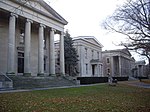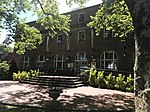Francis the Praying Mantis
Francis the Praying Mantis is the name of a sculpture depicting a praying mantis. The sculpture is located on the East Meadow in front of the Staten Island Children's Museum, on the grounds of Sailors' Snug Harbor, in Staten Island, New York.The original sculpture, built in 1991, was constructed from wood. It was designed and built by New York artist Robert Ressler.In 2011, the original was demolished due to water damage and, ironically, insect infestation. Francis was redesigned, fabricated and donated by self-taught Staten Island artist Lenny Prince. Francis "2.0" is crafted from over 50 pieces of sculpted metals, including sheet metal and stainless steel, various sized muffler pipes, re-bar and other found metal objects. The realistic multi-lensed eyes are crafted from catalytic converters.
Excerpt from the Wikipedia article Francis the Praying Mantis (License: CC BY-SA 3.0, Authors).Francis the Praying Mantis
Richmond Terrace, New York Staten Island
Geographical coordinates (GPS) Address Phone number Website Nearby Places Show on map
Geographical coordinates (GPS)
| Latitude | Longitude |
|---|---|
| N 40.64232 ° | E -74.10173 ° |
Address
Staten Island Children's Museum
Richmond Terrace 1000
10301 New York, Staten Island
New York, United States
Open on Google Maps








